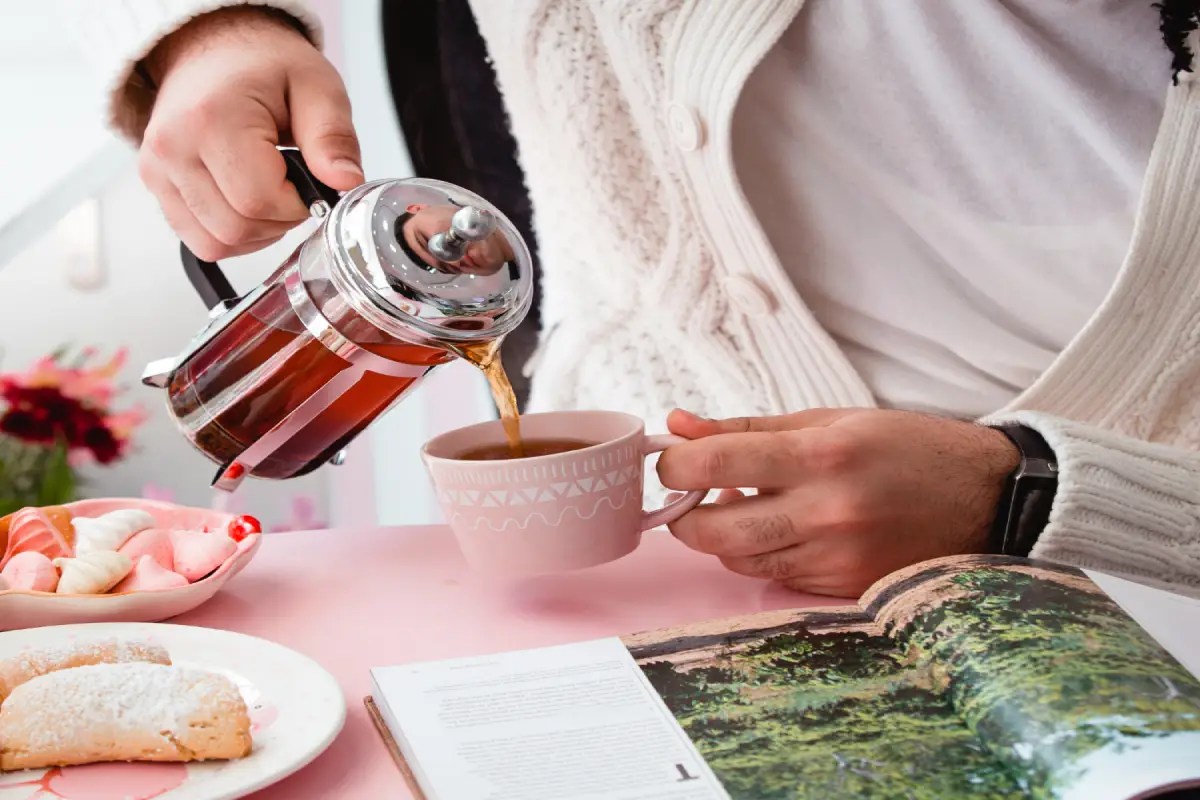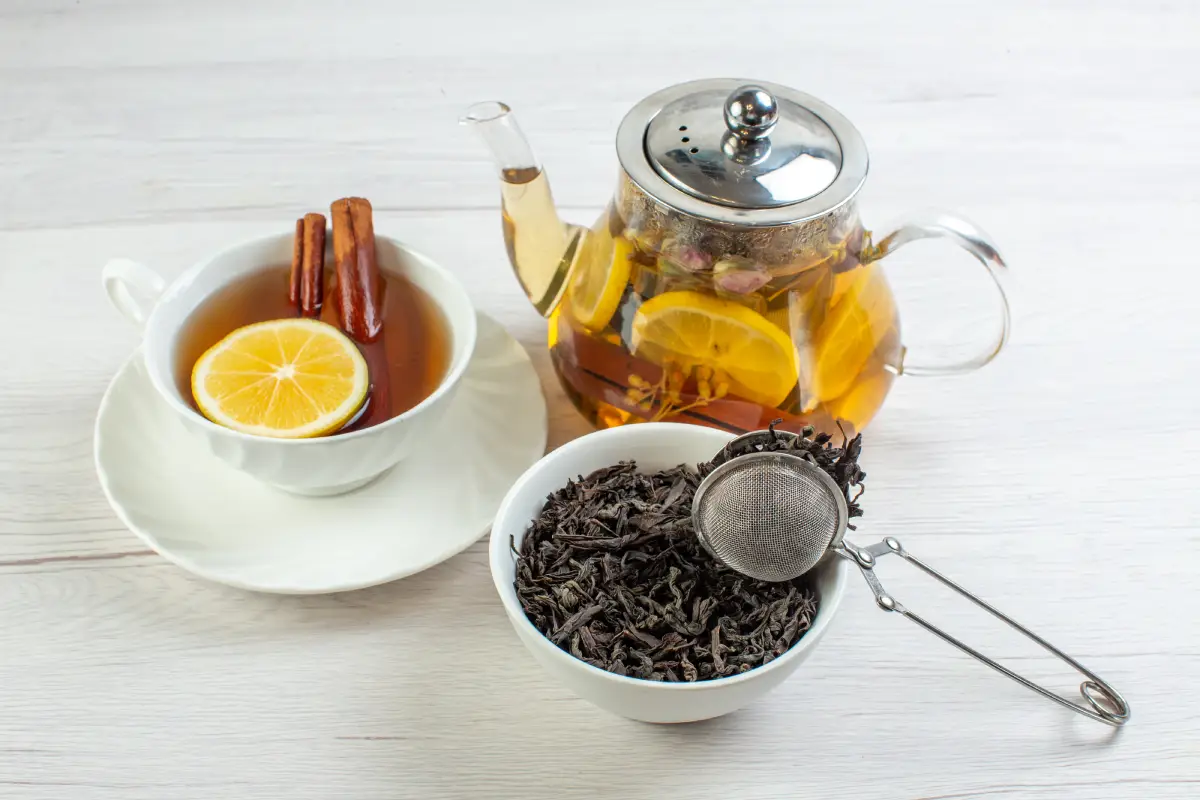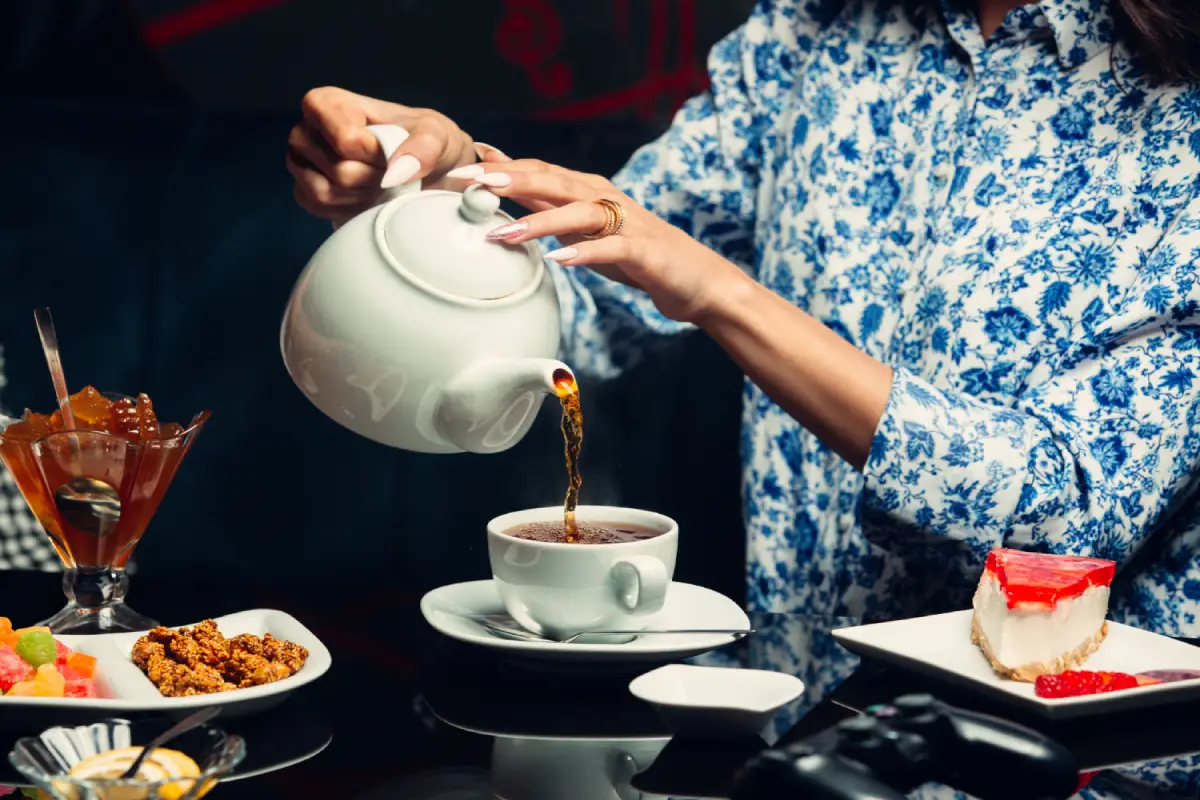Earl Grey tea shines in the tea universe, beloved for its unique aroma and taste. Why does it stand out? The secret lies in its blend of black tea with the citrusy essence of bergamot oil. This combination offers a refreshing yet comforting experience. Our guide delves into the best Earl Grey tea, tracing its origins and exploring its appeal.
This tea is not just a beverage; it’s a ritual and a bridge to cultures worldwide. Whether you are new to Earl Grey or a longtime fan, understanding its nuances elevates your tea experience. Hence, this guide aims to walk you through Earl Grey’s enchanting world.
We will discuss its history, health benefits, and the wide range of varieties available. Moreover, you will learn how to select, brew, and perfectly pair this tea. From classic blends to bold, new varieties, we will guide you to the best choices on the market. Whether seeking an energizing morning drink or an aromatic afternoon treat, our journey into Earl Grey tea promises both enlightenment and pleasure.
The Enchanting History
Earl Grey tea is not only celebrated for its unique flavor but also for its numerous health benefits. Rich in antioxidants, this tea offers a delightful way to support overall health and well-being. Here, we explore some of the most notable health advantages of incorporating this tea into your daily routine.
1. Heart Health:
Firstly, studies suggest that the flavonoids in Earl Grey tea can help improve heart health. Regularly drinking this tea may lower bad cholesterol levels while enhancing good cholesterol, reducing the risk of heart disease.
2. Digestive Aid:
Secondly, this tea has been known to aid digestion. It can alleviate symptoms of indigestion, colic, and constipation. The tea’s anti-inflammatory properties may also soothe an upset stomach.
3. Energy Boost:
Moreover, unlike some teas, Earl Grey contains caffeine, providing a gentle energy boost without the jitters associated with coffee. The bergamot in Earl Grey also has natural aromatherapy qualities, uplifting the mood and enhancing alertness.
4. Immune Support:
Furthermore, the antioxidants in the tea, particularly vitamin C from the bergamot, support the immune system. Drinking Earl Grey may help ward off colds and flu by enhancing the body’s natural defenses.
5. Stress Relief:
Additionally, the bergamot in this tea has been shown to have calming effects. It can reduce stress and anxiety levels, promoting relaxation. This makes Earl Grey a perfect choice for unwinding after a long day.
6. Oral Health:
Lastly, this tea contains catechins, which have antibacterial properties. These can help in fighting oral infections and reducing the formation of cavities.
Incorporating Earl Grey tea into your daily regimen can be a flavorful way to enhance health. Whether you’re seeking to boost your heart health, improve digestion, or simply enjoy a moment of calm, this tea offers a range of benefits that cater to both body and mind.
Exploring the Different Types
Earl Grey tea, with its distinctive blend of black tea and bergamot oil, offers more variety than many realize. As tea enthusiasts have grown in their appreciation of Earl Grey, producers have introduced several delightful variations. Here, we explore the main types of this tea, each offering a unique twist on the classic formula.
Classic Earl Grey:
The original Earl Grey tea combines black tea leaves with the oil of the bergamot orange. Its signature citrus aroma and taste have made it a favorite around the world.
Lady Grey:
A softer version of the classic, Lady Grey includes additional citrus peels and sometimes lavender or cornflower petals, providing a more delicate flavor and aroma.
French Earl Grey:
This variation adds a floral twist, incorporating rose petals and sometimes other flowers like lavender, which give it a sweet and aromatic complexity beyond the traditional bergamot.
Cream Earl Grey:
For those who enjoy a smoother, creamier taste, Cream Earl Grey blends the traditional bergamot flavor with vanilla and sometimes other creamy flavors, creating a rich and comforting tea experience.
Russian Earl Grey:
By adding ingredients like citrus peels and lemongrass, Russian Earl Grey offers a more robust and aromatic profile, appealing to those who seek a more intense flavor.
Decaffeinated Earl Grey:
For tea lovers who wish to enjoy Earl Grey later in the day without the caffeine kick, decaffeinated versions maintain the beloved flavor but without the stimulating effect.
Green Earl Grey:
A lighter alternative, Green Earl Grey uses green tea leaves instead of black, offering a fresher, more delicate taste profile while still featuring the signature bergamot flavor.
Rooibos Earl Grey:
Lastly, a caffeine-free option, Rooibos Earl Grey substitutes traditional black tea with rooibos, a South African herb, offering a unique twist with a nutty flavor complementing the bergamot.
Choosing the best Earl Grey tea depends on personal preference regarding flavor, aroma, and caffeine content. Whether you prefer the classic robustness, a floral fragrance, a creamy texture, or a caffeine-free alternative, there’s an Earl Grey blend that’s perfect for you.
How to Choose the Best Earl Grey Tea: Quality and Flavor
Selecting the best Earl Grey tea involves more than just picking any box off the shelf. The quality of the tea, the source of the bergamot, and the balance of flavors all play crucial roles in determining the overall experience. Here are essential tips to help you choose the tea that meets the mark of excellence.
1. Quality of Tea Leaves:
Firstly, the foundation of any great Earl Grey is the quality of the black tea used. Look for loose-leaf tea or tea bags that contain large pieces of leaves. High-quality leaves ensure a richer flavor and a more aromatic brew.
2. Source of Bergamot:
Secondly, authentic Earl Grey tea gets its distinct flavor from the oil of the bergamot orange. Ensure the Earl Grey you select uses natural bergamot oil rather than synthetic flavorings. The origin of the bergamot can also influence the taste; Italian bergamot is highly prized.
3. Balance of Flavors:
Furthermore, a well-crafted Earl Grey should strike a perfect balance between the robustness of the black tea and the citrusy notes of bergamot. Sample different brands to find one that harmonizes these elements to your liking.
4. Aroma:
Moreover, the fragrance of this tea is as important as its taste. The aroma should be inviting and distinctly citrusy, without overpowering the scent of the tea leaves. A good sniff can often be a preliminary indicator of quality.
5. Additional Ingredients:
Additionally, While purists may prefer the classic blend, others enjoy variations with added flavors such as vanilla, lavender, or even rose petals. Consider what additional ingredients might enhance your Earl Grey experience and look for blends that incorporate these elements thoughtfully.
6. Reviews and Recommendations:
Finally, don’t underestimate the power of reviews and recommendations. Explore what tea experts and fellow tea drinkers have to say about different Earl Grey teas. Their insights can guide you to some of the best blends on the market.
Armed with these tips, you’re well on your way to selecting an the tea that not only satisfies your taste buds but also elevates your tea-drinking ritual. Whether you’re in pursuit of the classic Earl Grey experience or something a bit more adventurous, the perfect blend is out there waiting for you.
Mastering the Brew: Tips for the Perfect Earl Grey Tea
Brewing the perfect cup of Earl Grey tea is an art that combines tradition with personal preference. Here are some key tips to help you enhance the natural flavors and aromas of Earl Grey, ensuring a truly delightful tea experience.
1. Start with Fresh, Cold Water:
Firstly, the quality of water can affect the taste of your tea. Begin with fresh, cold water, preferably filtered to remove any impurities that could alter the flavor.
2. Heat the Water to the Right Temperature:
Secondly, for black tea like Earl Grey, bring the water to a full boil (about 212°F or 100°C). If you’re brewing a Green Earl Grey, aim for a lower temperature (around 176°F or 80°C) to avoid bitterness.
3. Measure the Tea Correctly:
Thirdly, use about one teaspoon of loose-leaf tea per cup (8 oz or 240 ml) of water. Adjust the amount based on your taste preference for a stronger or milder brew.
4. Pre-warm Your Teapot or Cup:
Additionally, pouring hot water into a cold teapot or cup can lower the brewing temperature. Pre-warming them helps maintain the ideal temperature for steeping.
5. Steep for the Right Amount of Time:
Moreover, allow the tea to steep for 3 to 5 minutes. Shorter steeping times yield a milder flavor, while longer times bring out more depth and astringency. Adjust according to your preference.
6. Consider Adding Milk, Lemon, or Sweetener:
Furthermore, while Earl Grey is delightful on its own, some enjoy it with a splash of milk, a slice of lemon, or a bit of sugar or honey. Experiment to find your perfect combination.
7. Enjoy It Fresh:
Finally, this tea is best enjoyed fresh, right after brewing. This is when its aromatic flavors are most vibrant.
By following these steps, you can brew the perfect cup of Earl Grey tea that not only tastes great but also offers a moment of tranquility and pleasure. Whether you’re starting your day or taking a mid-afternoon break, a well-brewed Earl Grey can be the perfect companion.
Perfect Pairings
Pairing Earl Grey tea with the right foods can turn a simple cup of tea into a gourmet affair. The unique citrusy notes of bergamot in Earl Grey make it versatile for pairing with a variety of flavors, from sweet to savory. Here are some ideal companions for your next Earl Grey moment.
1. Classic Biscuits and Scones: Start with the basics. The traditional British tea time accompaniments like biscuits and scones, particularly when served with clotted cream and jam, beautifully complement the bergamot flavors of the tea.
2. Citrus-Infused Desserts: Earl Grey pairs splendidly with citrus-flavored desserts. Lemon tarts, orange zest cupcakes, or bergamot-infused cakes can enhance the tea’s citrusy profile, creating a harmonious taste experience.
3. Dark Chocolate: The bitterness of dark chocolate contrasts wonderfully with the slightly sweet, fragrant notes of Earl Grey. Enjoying a piece of dark chocolate with your tea can highlight the depth of both flavors.
4. Savory Sandwiches: For a more savory pairing, try Earl Grey with cucumber sandwiches or smoked salmon on whole-grain bread. The tea’s citrus notes cut through the richness, balancing the flavors elegantly.
5. Cheese: Surprisingly, certain cheeses pair well with Earl Grey. Soft, creamy cheeses like Brie or Camembert, with their rich textures, can be nicely offset by the tea’s bright and aromatic qualities.
6. Fruit Salads: A fresh fruit salad, especially with berries and citrus fruits, can complement the tea. The natural sweetness of the fruit pairs well with the bergamot’s tanginess.
Experimenting with these pairings can elevate your Earl Grey tea experience, transforming it from a mere beverage to a delightful culinary journey. Whether you’re enjoying a quiet moment alone or hosting an afternoon tea, these pairings promise to impress and satisfy.
Frequently Asked Questions (FAQs)
Can I drink Earl Grey tea every day?
Absolutely! Drinking Earl Grey tea daily can be a delightful part of your routine. It’s rich in antioxidants and offers numerous health benefits, such as supporting heart health and aiding digestion. However, since Earl Grey contains caffeine, it’s wise to moderate your intake depending on your sensitivity to caffeine.
Are all Earl Grey teas the same?
No, not all Earl Grey teas are created equal. The quality can vary significantly depending on the tea leaves’ quality, the source of bergamot oil (natural or synthetic), and the balance of flavors. There are also many variations, including Lady Grey, French Earl Grey, and others, offering a wide range of taste experiences.
What brand of Earl Grey do the British drink?
The British are known for their love of tea, and there are several popular brands of Earl Grey in the UK, including Twinings, which is often credited with introducing Earl Grey tea to the British public. Other notable brands enjoyed in the UK and worldwide are Fortnum & Mason, Harrods, and Taylors of Harrogate.
What goes best in Earl Grey tea?
Earl Grey tea is versatile and can be enjoyed in many ways. Some prefer it plain to savor the unique flavor of bergamot, while others enjoy it with milk, lemon, or honey. The best addition depends on personal preference. For those looking to further explore and experiment with pairings, our guide to the perfect pairings for Earl Grey tea delves into the best companions that enhance the unique flavors of Earl Grey, from delectable sweets to savory delights. Experimenting with different combinations can help you find your perfect Earl Grey experience.
How does bergamot benefit Earl Grey tea?
Bergamot oil, extracted from the peel of the bergamot orange, gives Earl Grey tea its distinctive flavor and aroma. Besides its captivating citrus scent, bergamot has been associated with health benefits, including stress relief and improved mood, making it a valuable addition to Earl Grey tea.
Conclusion: Celebrating the Timeless Elegance of Earl Grey Tea
Our journey through the world of Earl Grey tea has revealed the depth and versatility of this classic beverage. From its intriguing origins steeped in legend to the myriad health benefits it offers, Earl Grey tea stands out as a distinguished choice among tea lovers.
We’ve explored the various types of Earl Grey, each offering a unique twist on the traditional blend of black tea and bergamot oil. Whether you prefer the classic flavor, a floral-infused French Earl Grey, or a creamy variation, there’s an Earl Grey for every palate.
Selecting the best tea involves considering the quality of tea leaves, the source of bergamot, and the balance of flavors. Brewing the perfect cup requires attention to water quality, temperature, and steeping time, allowing the distinct citrusy aroma and rich taste of Earl Grey to shine through.
Pairing the tea with the right foods can elevate your tea experience, whether it’s with classic biscuits and scones, citrus-infused desserts, or savory sandwiches. The versatility of Earl Grey makes it a delightful companion to a wide range of dishes.
In answering common questions about Earl Grey, we’ve affirmed its place as a daily pleasure that can be enjoyed in various ways, according to personal taste and preference. The presence of bergamot not only enriches Earl Grey with its distinctive flavor but also contributes to its health-promoting properties.
Earl Grey tea, with its elegant blend of flavors and aromas, invites us to pause and savor the moment. It’s more than just a beverage; it’s a ritual, a small luxury that enriches our daily lives. As we conclude this guide, we celebrate this tea not only for its timeless elegance but also for the moments of joy and tranquility it brings to our busy lives.






